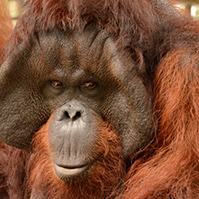Orangutan of the Month for December 2019.
SUMMER: Stubborn but Sweet
Orangutan hair may be a flaming dusky red but it provides excellent camouflage when orangutans are in tangled shrubbery and in the forest canopy where the sun doesn’t shine. Like… Continue reading Orangutan of the Month for December 2019.
SUMMER: Stubborn but Sweet
Orangutan of the Month November 2019.
BANDA: Charisma Strong
The hanging vines and sturdy trees in Orangutan Foundation International’s (OFI) Learning Forest in Central Kalimantan (Indonesian Borneo) have borne witness to many young orangutans over the years. The vines… Continue reading Orangutan of the Month November 2019.
BANDA: Charisma Strong
Orangutan of the Month for October, 2019: Judy
Let’s talk about Judy! Orphan orangutans who are kept in private households are often placed in situations completely outside of their normal understanding. Judy was one of these as she… Continue reading Orangutan of the Month for October, 2019: Judy
Orangutan of the Month for September, 2019: Boncel
Back to the Wild
The release of an orangutan back to the wild is a culmination of many years of hard and dedicated work. It is a profound moment when wild born ex-captive orangutans… Continue reading Orangutan of the Month for September, 2019: Boncel
Back to the Wild
Orangutan of the Month for August 2019: Mumui,
Explorer in the Making
Youth is a time when individuals are trying to find their way through life. It is a time of experimentation, trying new things, and seeing what suits us. Through exploration… Continue reading Orangutan of the Month for August 2019: Mumui,
Explorer in the Making
Bear of the Month for July, 2019: ORI,
Komet’s best friend
Some sun bears are instantly more recognisable than others, Ori is one of them, with his big head and wide set eyes. He sports a white bib like chest patch.… Continue reading Bear of the Month for July, 2019: ORI,
Komet’s best friend
Orangutan of the Month for June, 2019: Jambul2
What is in a name? Names can be very powerful, reflecting one’s character and identity. Names are associated with family but there is so much more to families than we… Continue reading Orangutan of the Month for June, 2019: Jambul2
Bear of the Month for May 2019: Chaos with Komet
Komet the bear is an extremely playful soul. His one purpose in life seems to be having a good time, an admirable quality especially for a Malayan sun bear. If… Continue reading Bear of the Month for May 2019: Chaos with Komet
Orangutan of the Month for April, 2019: Tunas
There are many sides to an orangutan’s personality with some characteristics and personality types more prominent then others. There are shy orangutans, adventurous orangutans, and placid orangutans. With some orangutans… Continue reading Orangutan of the Month for April, 2019: Tunas
Employee Spotlight: Ibu Ijun
Everyone has a story to tell, and at Orangutan Foundation International (OFI), the colorful tales are endless. Each caregiver at OFI’s Orangutan Care Center and Quarantine (OCCQ) in Central Borneo,… Continue reading Employee Spotlight: Ibu Ijun












